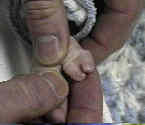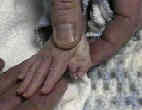- See: Polydactyly:
- Discussion:
- polydactyly of the thumb occurs in many forms, ranging from varying degrees of mere splitting to completely duplicated thumb;
- occasionally it consists of only fleshy nubbins on radial border;
- when duplication occurs alone, it is usually unilateral and sporadic;
- duplication associated w/ triphalangeal thumb usually results from autosomal dominant inheritance;
- thumb polydactyly is part of a variety of syndromes, but these syndromes do not occur very frequently;
- Classification: Types I to VII based on level of duplications;
- I : bifid distal phalanx (DP)
- II: duplicated DP
- III: bifid proximal phalanx (PP)
- IV: most common type w/ duplication of proximal phalanx which rest on broad metacarpal;
- V: bifid metacarpal (MC)
- VI: duplicated MC
- VII: triphalangism
- Treatment:
- main postoperative complications are diminished digit size and MCP instability (w/ type IV duplications);
- surgical stratedgy is to augment thumb reconstruction with accessory digit;
- duplicated thumb is skeletonized and removed at the MCP joint, retaining all of its soft tissue structures (which help augment size of the finger);
- if there are two equal digits, one should remove the radial one and reconstruct the radial collateral ligament rather than the ulnar collateral ligament;
- ulnar collateral:
- when duplication is at level of joint, types II and IV, collateral ligament of the digit to be discarded needs to be preserved and sewn to
the remaining digit across the retained joint;
- if MCP joint remains unstable, fusion of MP joint is considered when the child reaches the age of ten or 12;
- tendons:
- EPL and FPL may be split and insert on both digits, each w/ an eccentric insertion;
- duplicated EPL and FPL should be transfered over to the remaining digits;
- abductor brevis may attach to the preaxial duplicated digit and the adductor pollicis attaches to the other digit;
- abductor brevis is transferred along w/ its periosteum to an anatomic insertion site on the other digit, just distal to the epiphysis;
- alternatively, the abuctor brevis can be transferred over, w/ a small piece of bone (requires a K wire for fixation);
- web space:
- web space may be contracted, in which cases the dorsal skin from the discarded digit should be used to assist w/ web space deepening;
- Bilhaut Cloquet Procedure:
- reconstruction involving sharing of equal sized digits, most indicated for types I and II deformities;
- a single nail is preserved to maintain normal size;
- Treatment of Type IV:
- should be treated very early, because if one waits too long, the supernumerary component displaces the normal component into marked
radial or ulnar deviation, and growth continues in this direction;
- w/ this deformity, consider leaving the collateral ligament attached to a fleck of bone from the metacarpal head along w/ surrounding periosteum;
- Complications:
- late Z-deformity is common complication of removal of extra thumb;
- Z-deformity is characterized by ulnar deviation at MP joint & radial deviation at the interphalangeal joint of thumb;
- multiple factors related to several different problems inherent in polydactyly may cause this deformity
Thumb duplication, 66 years' experience--a review of surgical complications.
Duplication of the thumb. A retrospective review of two hundred and thirty-seven cases.
Polydactyly of the thumb: abnormal anatomy and treatment.
The results of surgery for polydactyly of the thumb. A review.
An appropriate treatment for postoperative Z-formed deformity of the duplicated thumb.
Modified Bilhaut-Cloquet Procedure for Wassel Type-II and III Polydactyly of the Thumb.



